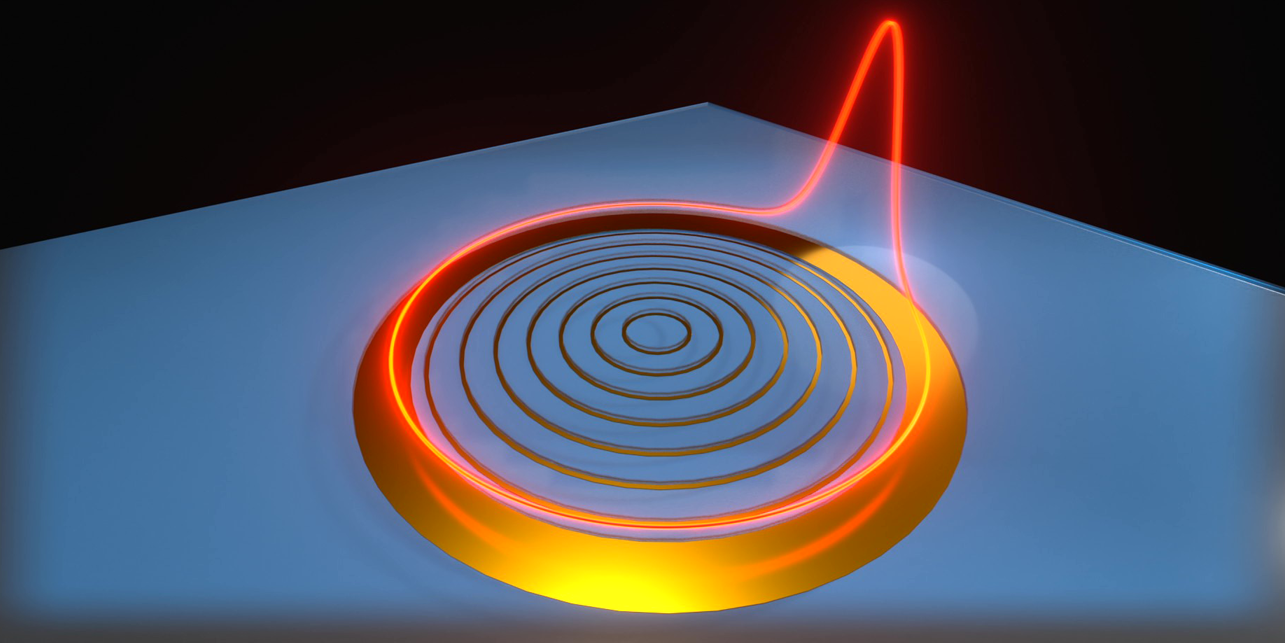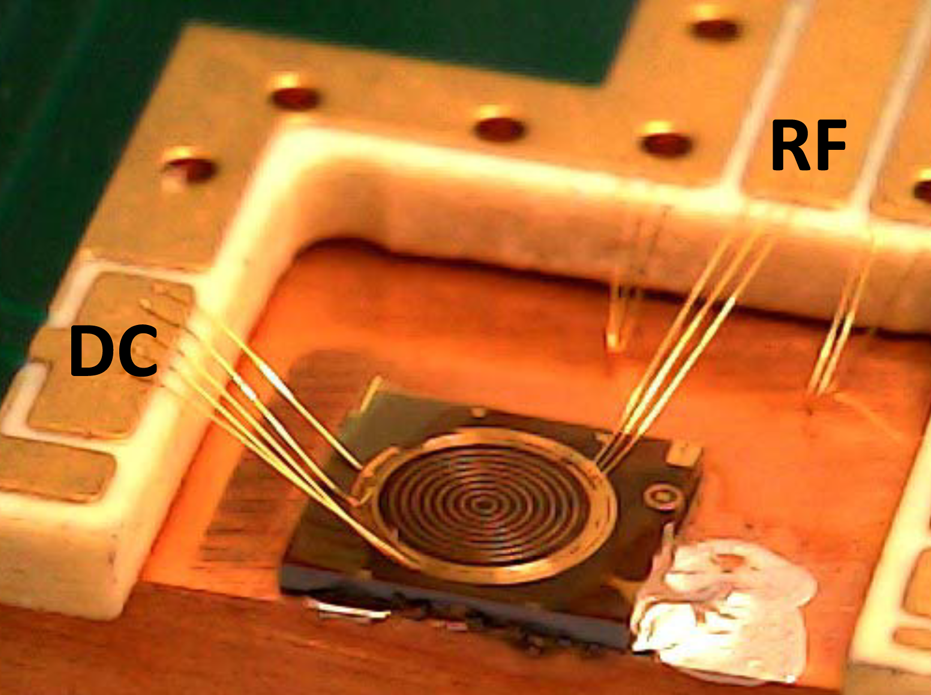Optical solitons go terahertz
In a feat of optical waveguide engineering, researchers from the Institute for Quantum Electronics at ETH Zurich have successfully observed terahertz solitons in a ring quantum cascade laser.

Optics is a field that lends itself to being a testbed for a broad variety of physical phenomena. Quantum optical setups, for example, allow researchers to investigate fundamental properties such as quantum entanglement as well as applications like safe communication protocols. Optical fibers and externally pumped microresonators – planar or ring-shaped micrometre-scale structures that confine light – are two systems where it is possible to investigate the properties and applications of solitons, wave packets that maintain their shape as they propagate through a dispersive medium. Theoretical work predicted the formation of optical solitons in other platforms too, for instance, in quantum cascade lasers (QCLs) embedded in ring cavities. Finding unambiguous experimental evidence for the onset of the dissipative soliton regime in semiconductor ring lasers, however, has proved challenging.
Paolo Micheletti and colleagues from the Quantum Optoelectronics group of Jérôme Faist and Giacomo Scalari in the Institute for Quantum Electronics at ETH Zurich have combined their expertise in semiconductor lasers with advanced optical engineering to generate terahertz optical solitons with a ring QCL. The result, recently published in Science Advances, paves the way for extending the reach of semiconductor lasers as sources of ultrashort pulses at terahertz frequencies.
Keeping the balance
In the early 2000s, externally pumped microresonators were recognised as a new platform for generating optical frequency combs and, under specific conditions, optical cavity solitons known as dissipative Kerr solitons (DKSs). DKSs are self-organised waveforms that are not altered in their shape as they traverse dispersive, nonlinear and lossy media. DKSs arise out of a double balancing act: the first requires that the losses plaguing the optical cavity are balanced out by the external optical pumping for a passive microresonator (or, in the presence of an active medium in the cavity, by the active region's gain). The other has to do with how the wave packet is affected by the nonlinear medium as it propagates through it: for soliton formation, the effect of dispersion (namely, the dependence of the soliton's group velocity on frequency) and the third-order Kerr nonlinearity must counteract one another.
QCLs are already known as alternative and versatile sources of Kerr frequency combs. Their Kerr nonlinearity is large, and their wavelength tunability means they can cover a wide frequency range. Notably, QCL comb operation was achieved at mid-infrared and terahertz frequencies, both highly relevant for spectroscopy and sensing applications. A natural further step is to investigate soliton formation: last year, members of the Faist group reported on mid-infrared soliton generation in a ring QCL with high intracavity power and low optical losses. In this and further work, they identified two conditions that must be met for DKSs to appear. First, optical backscattering must be sufficiently low to allow for unidirectional lasing. Second, the cavity has to be engineered in a way that ensures the anomalous dispersion required to balance out the large Kerr nonlinearity.
At terahertz frequencies, the semiconducting heterostructures of QCLs display a large normal dispersion: this adds an extra challenge to the requirement of anomalous dispersion for terahertz soliton formation in semiconductor lasers. The geometry of ring QCLs – without a preferential output port for light – also makes power extraction difficult, which means that comb state characterisation is non-trivial. The work by Paolo Micheletti and colleagues addressed successfully both bottlenecks, providing long-sought evidence of terahertz optical solitons in ring QCLs.
A carefully designed system
The active region of the ring QCL is a narrow ridge between two concentric metal waveguides dry-etched onto a substrate to form a ring with a diameter of 800 μm. A benzocyclobutene (BCB) layer is spin-coated, baked and etched so that its height matches that of the waveguides. In this way, the active region is encapsulated in BCB but not covered by it: this design is referred to as waveguide planarisation. A wide metal contact is deposited over the active region, extending onto the BCB area so that bonding wires can be placed over the BCB layer instead of the waveguides. This detail is crucial because wires can introduce defects into the active region.
Planarisation allows the width of the waveguides to be much smaller than that required for wires placed in direct contact with the active region. A geometry with such narrow waveguides separated by a similarly narrow gap favours the selection of a lasing mode characterised by anomalous dispersion, hence waveguide planarisation is key to soliton formation in the ring QCL considered by Micheletti and coworkers. At the same time, this design makes it possible to integrate a bullseye antenna onto the BCB layer for improved light extraction from the cavity, which in turn facilitates the task of verifying that an optical soliton is indeed present.

Characterising the light emission
In the time domain, optical solitons are short pulses with durations ranging from a few picoseconds down to the femtosecond scale; in the frequency domain, a single soliton is described by a broad, smooth comb spectrum with closely spaced modes and a squared hyperbolic secant (sech2) power envelope shape.
Micheletti and colleagues observed power spectra with the expected sech2 shape in free-running and weakly radiofrequency-injected ring QCLs. However, a time-domain analysis of the emitted terahertz radiation – including phase measurements demonstrating the inter-mode coherence of the comb – is needed to conclude that DKSs are present. For this purpose, the authors integrated the bullseye antenna into the device and ran shifted wave interference Fourier transform spectroscopy (SWIFTS) measurements to study the temporal properties of the terahertz comb. For light detection, they used fast superconducting hot electron bolometers provided by colleagues from the Consiglio Nazionale della Ricerca (CNR) in Italy. This characterisation confirmed the generation of frequency combs corresponding to optical solitons with a pulse length of 12 ps. The data also showed a markedly hysteretic behaviour for the ring QCL laser: a fast change in the laser bias led to the frequency comb lasing state, whereas a slow ramping up of the bias current didn't bring the laser out of single-mode operation.
Terahertz QCL combs still require cryogenic temperatures, but the findings of Micheletti and coworkers suggest a way to make compact sources of ultrashort terahertz pulses out of semiconductor lasers. This shows that quantum cascade lasers are both valuable platforms for studying phenomena such as soliton formation and a technology with promising applications.
Reference
Micheletti, P. et al. Terahertz optical solitons from dispersion-compensated antenna-coupled planarized ring quantum cascade lasers. Sci. Adv. 9, eadf9426 (2023). external page DOI:10.1126/sciadv.adf9426
Further reading
Tutorial on quantum cascade lasers from the Quantum Optoelectronics group
Tutorial on frequency combs from the Quantum Optoelectronics group